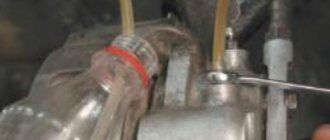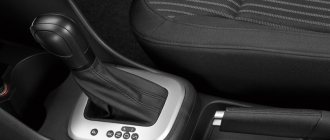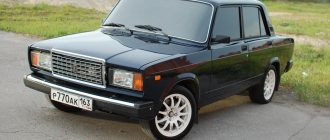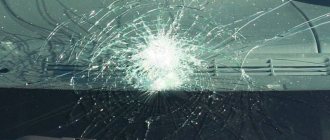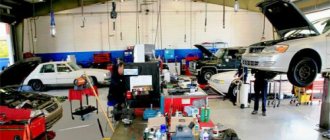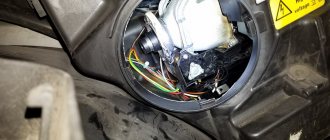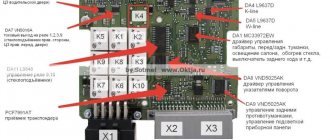ZAZ 1102, 1105, Tavria. Repair manual and parts catalog
free e-manual
- Currently 3.42/5
- 1
- 2
- 3
- 4
- 5
3.4 out of 5 (83)
Auto repair manual Tavria - Slavuta - Dana in electronic form. The manual will always be at hand during car maintenance and repair; to do this, just download it for free to your tablet or phone in djvu format.
Before using the car manual, check the year of manufacture and engine of the car.
Russian language
Format: djvu
Size: 12.9 Mb
File downloaded 722 times
Where is the file?
Book ZAZ 1102, 1105, Tavria. The repair manual and parts catalog are located on our server in djvu format.
The storage is securely isolated from virus threats, has high throughput and provides the ability to download files for free 24/7
How to download the book?
Download link , confirm that you have read the terms of use and download the file to your device.
If you have any difficulties, use the feedback form. We will try to resolve the problem and respond to you as quickly as possible.
It's free?
Any of our visitors can download the book ZAZ 1102, 1105, Tavria for free. Repair manual and parts catalogue . This does not require any additional steps other than downloading the file directly.
Learn more about how to download the Tavria-Slavuta-Dana repair book for free.
Repair book Tavria - Slavuta - Dana free in djvu format
"Slavuta"
“Slavuta” rolled off the assembly line from 1999 to 2011. She belongs to category "B". A liftback type body was installed. The engines with which these models were equipped are designed for 1.1, 1.2, 1.3 liters (carburetor), as well as 1.2 and 1.3 liters (injection). The development of the Slavuta, which is related to the ZAZ-1102, began due to the fact that the Dana did not meet the modern requirements of drivers at that time, due to which it was not in particular demand. Almost six months later, the 1.1 liter carburetor engine was replaced by a 1.2 liter analogue. And in 2002, the most expensive model for the entire production period appeared on the markets - a car with a 1.3 liter injection engine. However, the latter option was not suitable for sale due to strict environmental regulations. In January 2011, the plant stopped producing Slavuta.
The body has 5 doors, it is made of all-metal material, it is of a closed and load-bearing type. The rear window opens together with the tailgate. The vehicle weight is 800 kg. Tank volume – 38 l.
The engines that were installed on the Slavuta were developed and produced at the Melitopol plant. All units are designed for 4 cylinders. The exhaust pipe is located at the rear on the left. The ignition (ZAZ-1102 is equipped with a similar system) has a battery structure and a non-contact voltage of 12 Volts.
ZAZ 1102, 1105, Tavria. Repair manual and parts catalog
Operation of any Tavria-Slavuta-Dan car is impossible without knowledge of its structure, maintenance and repair features. It doesn’t matter who will carry out the necessary work - every driver is simply obliged to know the basic maintenance and troubleshooting procedures.
The Tavria - Slavuta - Dana repair book contains all the necessary information that will help the owner understand the structure of the car, teach how to properly care for the car, timely maintenance and proper repairs.
The Tavria - Slavuta - Dana repair manual is divided into chapters: Vehicle design (describes general information and vehicle registration data); Operating instructions (preparation for departure, recommendations for traffic safety); Malfunctions along the way (tips to help you in case of an unexpected breakdown on the road); Maintenance (detailed recommendations for all maintenance procedures); Repair instructions (engine, transmission, chassis, steering, brake system, and also includes assembly and disassembly work necessary during the repair process Tavria - Slavuta - Dana); Electrical equipment (detailed manual for diagnostics and troubleshooting, the main units are described separately and detailed electrical diagrams of Tavria - Slavuta - Dana are given).
Any of the repair procedures Tavria - Slavuta - Dana is given according to the principle from simple to complex: from the simplest maintenance operations, adjustments, replacement of parts, to global repairs with assembly and disassembly work.
All materials in the book are based on specific experience gained in the process of complete disassembly and assembly of Tavria - Slavuta - Dan by highly qualified auto mechanics.
Book “ZAZ 1102, 1105, Tavria. Repair manual and parts catalog" is necessary so that diagnostics and repairs of Tavria - Slavuta - Dana can be done professionally and quickly, even by the owner of the car who still has little practical experience.
You can download the Tavria - Slavuta - Dana repair manual for free in djvu format . You just need to download it to your phone or tablet and you can use it in any situation on the road.
Story
At the end of the 1960s, the design bureau proactively began developing a front-wheel drive small-class car under the motto “Perspective” to replace the Zaporozhets ZAZ-966, using experimental developments by NAMI (NAMI-0132) and, later, VAZ-a (VAZ-3E1101) [ specify
].
In the 1970s, several experimental models were created with hatchback and two-door sedan bodies. However, the technical specifications for development were officially received from the USSR Ministry of Automotive Industry only in 1978.
After the production of the pilot batch and the start of the fine-tuning process, the Ministry of Automotive Industry - quite in the style of its then head V.N. Polyakov - radically changed the task, forcing the factory design bureau to redesign the car with an eye on the popular European model Ford Fiesta of 1976 - despite the purely negative assessment of this models by the plant team. Factory tester Ivan Pavlovich Koshkin later recalled about the Ford Fiesta[1]:
In Europe, this car has been loudly advertised since 1976 as the ultimate in perfection. But when I received it for comparative testing and tested it on the roads, it turned out that there was nothing in common with the advertising. The rear passengers are knocked out by a small pothole. The driver bows all the time on a rough road - his head is so wobbly due to the misalignment of the suspension. To save one hinge, the steering wheel was installed not like a human, but at an angle to the longitudinal axis of the car. Can you imagine this “oblique” steering? We have been taught to think that Western designers have a star on their forehead. And they are the same mortal engineers, not immune from mistakes.
At the same time, the designers were given the goal of surpassing the Fiesta in terms of performance. Approximately the same thing happened in the same years with AZLK, which, under pressure from Polyakov’s department, was forced from scratch to design a fundamentally new front-wheel drive platform - the future Moskvich-2141, despite the presence of a completely modern rear-wheel drive prototype S-, which was already at the pre-production stage. 3.
The development task continued to change - the Ministry of Automotive Industry put forward more and more new requirements to exceed the parameters of various foreign “small cars” of those years: “Fiat Uno”, “Austin Metro” and others. This, together with a lack of funding, which until the mid-1980s went mainly to the development of new front-wheel drive models from the Volzhsky plant, led to an extreme delay in the introduction of the car into production.
The first production Tavrias rolled off the assembly line on November 18, 1987[2], the cost of the car was 5,100 rubles[3]. Simultaneously with the standard version, production of the ZAZ-1102 in the “norm” configuration was launched [4].
At that time, Tavria was positioned as an extremely economical car. In 1989, the USSR Ministry of Automotive Industry released a commercial[5] for the Western market, in which the driver refueles a Tavria from his lighter. This video won the Bronze Lion in the Trade Advertising category at Cannes.
In 1989, mass production of the ZAZ-110206[6] model began (which received double-row ball bearings in the front wheel hubs, new headlights with an inclined lens, additional direction indicators on the wings, new door locks, seats with headrests and decorative trim moldings - as a result the weight of the car increased by 17 kg, the cost - up to 5429 rubles) [7]. In 1991, 41,832 ZAZ-1102 vehicles and their modifications were produced[8].
In July 1992, the chief designer of AvtoZAZ, O. Kh. Papashev, said in an interview that the plant had produced 60 thousand ZAZ-1102 vehicles and their modifications and intended to begin mass production of new models: ZAZ-1103, ZAZ-1105 and an electric car based on based on ZAZ-1102[9].
In the summer of 1992, the plant began production of the ZAZ-11024 station wagon model[10]. Also in 1992, an experimental electric car was developed and built on the basis of the ZAZ-1102, but the cost of the car turned out to be several times higher than that of the base model with a gasoline engine[11].
In 1993, the plant produced 53,027 ZAZ-1102 vehicles and their modifications[12]
In 1994, production of the ZAZ-1105 “Dana” began, a modification with a station wagon body.
In 1998, the ZAZ-1102 on the assembly line began to replace the ZAZ-1102 “Tavria-Nova” - a modification created jointly with Daewoo, aimed at eliminating identified deficiencies and improving technical and operational indicators (over 700 in total). The Tavria Nova underwent cosmetic modernization of the radiator grille, headlights and taillights, and also began to use new decorative caps on 4.5J wheel rims with tubeless tires, and a third brake light was installed on the rear door. To increase the reliability of the car and increase the level of passive safety, the load-bearing and technological elements of the body were strengthened, which made it possible to reduce the noise level in the cabin.
In 1999, serial production of the ZAZ-1103 “Slavuta” model with a liftback body began.
In 2006 and 2007, the plant management announced several times that the model would soon be discontinued from production. Mass production of the ZAZ-1102 “Tavria” model with a hatchback body was completed in 2007, although individual copies were assembled until the fall of 2009. Production of the ZAZ-1103 “Slavuta” and ZAZ-11055 “Pick-Up” continued.
The body of the last production car ZAZ-1103 “Slavuta” was welded on January 14, 2011, and on January 15, dismantling of equipment and production lines began at ZAZ in connection with the planned transfer of the T250
with FSO in Zaporozhye. At the end of January 2011, the last ZAZ-1103 “Slavuta” rolled off the assembly line, which was sold at an online auction on February 11, 2011 for 47,020 hryvnia.
The successor to “Slavuta” on the assembly line was ZAZ Forza.
ZAZ 1102, 1105, Tavria. Repair manual and parts catalog
download the Tavria - Slavuta - Dana repair book for free and use it on any device
djvu format , size 12.9 Mb
File downloaded 722 times
How can you be the first to know about new books and magazines?
Subscribe to the newsletter and we will send you an email after updating the catalogs
"Pickup"
This car is a modification of the original Dana model. Any buyer could custom install a soft or hard top (optional), which easily turns the van into a cargo-carrying vehicle. The compartment where all the luggage fits is separated from the driver and passenger seats by an ordinary partition with glass. The production of the Pickup, which is based on the ZAZ Tavria-1102, began in 1992 and lasted until 2014.
The units installed on the machine had different characteristics regarding volume: from 1.1 to 1.3 liters.
Most of the details were borrowed from Dana. They differ from each other in the rear bumper, the lights of the same part of the car, and the window in the partition (in the newer version, a grille appeared on it). The pickup truck received updated side mirrors and an awning that can be installed on the grille of the cargo compartment, as well as a suspension. Repairing this model, like repairing the ZAZ-1102, will not require much time, effort and money. Therefore, such a car is quite in demand.
Maintenance schedule
| Service object and types of work | Maintenance frequency | |||||||||||
| Mileage (km) or period of operation (years), whichever comes first* | ||||||||||||
| × 1000 | 1-2 | 10 | 20 | 30 | 40 | 50 | 60 | 70 | 80 | 90 | 100 | |
| Year of operation | — | 1 | 2 | 3 | 4 | 5 | 6 | 7 | 8 | 9 | 10 | |
| POWER UNIT SYSTEMS | ||||||||||||
| Tightening the threaded connections of the power unit (brackets to the power unit, cushions to the brackets on the power unit, cushions to the body) | TO | TO | TO | TO | TO | TO | TO | TO | TO | TO | TO | |
| Adjusting the tension of the generator drive belt or replacing | R | R | R | R | R | R | Z | R | R | R | R | |
| Check the presence of grease in the generator bearings, add if necessary | — | — | — | — | — | — | TO | — | — | — | — | |
| Lubrication of screw splines and starter rotor bushings | — | — | — | — | — | — | TO | — | — | — | — | |
| Adjusting the tension of the timing belt or replacing | R | R | R | R | R | R | Z | R | R | R | R | |
| Changing the engine oil and oil filter | Z | Z | Z | Z | Z | Z | Z | Z | Z | Z | Z | |
| Checking the oil level in the gearbox. Changing the gearbox oil (3) | Z | TO | TO | TO | TO | Z | TO | TO | TO | TO | Z | |
| Cooling system (tightness of hoses and their connections, activation of the electric fan) | TO | TO | TO | TO | TO | TO | TO | TO | TO | TO | TO | |
| Coolant | TO | TO | TO | Z | TO | TO | Z | TO | TO | Z | TO | |
| Fine fuel filter (MeMZ: 245,2457,3011, 3071) | — | Z | Z | Z | Z | Z | Z | Z | Z | Z | Z | |
| Fuel pipelines and their connections | TO | TO | TO | TO | TO | TO | TO | TO | TO | TO | TO | |
| Air cleaner filter element (1) | K, O | Z | Z | Z | Z | Z | Z | Z | Z | Z | Z | |
| Ignition timing (MeMZ: 245,2457,3011) | R | R | R | R | R | R | R | R | R | R | R | |
| Adjusting the gaps between spark plug electrodes or replacing spark plugs | R | R | R | Z | R | R | Z | R | R | Z | R | |
| Cleaning the internal cavity of the cover and high-voltage contacts of the ignition sensor-distributor (MeMZ: 245,2457,3011) | — | — | — | — | — | K, O | K, O | K, O | K, O | K, O | K, O | |
| Flushing the positive crankcase ventilation system | — | TO | TO | TO | TO | TO | TO | TO | TO | TO | TO | |
| Checking the tightness of the cylinder head bolts | TO | — | — | — | — | TO | — | — | — | — | TO | |
| Clearances in the valve drive mechanism | R | R | R | R | R | R | R | R | R | R | R | |
| Monitoring the condition and washing the filter inside the fuel pump (MeMZ: 245,2457,3011) | — | K, P | K, P | K, P | K, P | K, P | K, P | K, P | K, P | K, P | K, P | |
| Wash the carburetor with an aerosol composition, check and adjust its systems (MeMZ: 245,2457,3011) | — | — | K, P | — | K, P | — | K, P | — | K, P | — | K, P | |
| Checking engine idling with monitoring and adjustment of exhaust gas toxicity | K, R | K, R | K, R | K, R | K, R | K, R | K, R | K, R | K, R | K, R | K, R | |
| Checking the operation of devices of the central single-point fuel injection system with monitoring the content of harmful substances in the exhaust gases (MeMZ: 246) | — | TO | TO | TO | TO | TO | TO | TO | TO | TO | TO | |
| Replacing the small fuel filter (MeMZ-246) | Z | Z | Z | Z | Z | Z | Z | Z | Z | Z | Z | |
| Replacing both fuel filters (MeMZ-246) | Z | Z | Z | Z | Z | Z | Z | Z | Z | Z | Z | |
| Checking all ECM parameters with a tester that monitors the content of harmful substances in exhaust gases (MeMZ-3071) | K, R | K, R | K, R | K, R | K, R | K, R | K, R | K, R | K, R | K, R | K, R | |
| Monitoring the condition of the terminals of the ignition sensor-distributor connectors, reverse light switch, thermal relay for turning on the radiator fan, starter, generator, electric fan | TO | TO | TO | TO | TO | TO | TO | TO | TO | TO | TO | |
| Checking the battery charge level, lubricating the terminals, tightening the terminal connections | — | TO | TO | TO | TO | TO | TO | TO | TO | TO | TO | |
| On an engine with a gas equipment system, check the operation of the system components and the absence of gas leaks. | K, R | K, R | K, R | K, R | K, R | K, R | K, R | K, R | K, R | K, R | K, R | |
| CHASSIS AND BODY | ||||||||||||
| Brake fluid | TO | TO | TO | Z | TO | TO | Z | TO | TO | Z | TO | |
| Front brake pads and discs | — | TO | TO | TO | TO | TO | TO | TO | TO | TO | TO | |
| Rear brake pads and drums | — | TO | TO | TO | TO | TO | TO | TO | TO | TO | TO | |
| Parking brake | TO | TO | TO | TO | TO | TO | TO | TO | TO | TO | TO | |
| Lubricant in the parking brake cable sheaths | — | — | TO | — | TO | — | TO | — | TO | — | TO | |
| Brake hydraulic pipelines and their connections | — | TO | TO | TO | TO | TO | TO | TO | TO | TO | TO | |
| Adjust the rear wheel hub bearings and replace the grease | TO | TO | TO | TO | TO | K, W | TO | TO | TO | TO | K, W | |
| Clutch and brake pedal (free play) | TO | TO | TO | TO | TO | TO | TO | TO | TO | TO | TO | |
| Tightening threaded connections of suspension parts and exhaust system | TO | TO | TO | TO | TO | TO | TO | TO | TO | TO | TO | |
| Tire conditions | TO | TO | TO | TO | TO | TO | TO | TO | TO | TO | TO | |
| Wheel alignment angles | TO | TO | TO | TO | TO | TO | TO | TO | TO | TO | TO | |
| Steering mechanism and steering gear | — | TO | TO | TO | TO | TO | TO | TO | TO | TO | TO | |
| Covers and hinges of axle shafts | — | TO | TO | TO | TO | TO | TO | TO | TO | TO | TO | |
| Seat belts | — | TO | TO | TO | TO | TO | TO | TO | TO | TO | TO | |
| Lubricating hinges, latches, stops and axes of door lock rotors, hood hinges and latch, exterior handle hinges, front seat slides | — | TO | TO | TO | TO | TO | TO | TO | TO | TO | TO | |
| Take a test drive to ensure the vehicle is in good working order. | TO | TO | TO | TO | TO | TO | TO | TO | TO | TO | TO | |
Note * The table shows average vehicle mileage values. For more accurate mileage, see technical service coupons.
Designations:
K - check and, if necessary, make adjustments, cleaning, tightening, lubrication, adding operating fluids and eliminate detected faults, replace failed parts.
P, O - rinse, clean.
(1) - when used in heavy duty or unfavorable conditions, that is, with frequent trips over short distances, prolonged idling of the engine, or if the vehicle is operated in areas with dusty air, the engine oil and filters should be changed after 5,000 km. or 6 months of operation, whichever comes first. It is recommended to check the engine oil level before each trip.
(2) — if necessary, rearrange and balance the wheels.
(3) - when operating a car with TAD-17 oil, change the oil every 30,000 km.
The “+” sign indicates the work that is being performed.
The “-” sign indicates work that is not being performed.
History of ZAZ (Zaporozhye Automobile Plant)
Unlike many automobile enterprises in Russia and the CIS countries, the beginning of whose work biography dates back to the second or, which is much less common, the first half of the twentieth century, the Zaporozhye Automobile Plant has a glorious and rather long history. The company was founded back in 1863 by the Dutchman Abraham Koop, a colonist by birth, and initially specialized in the production of agricultural machinery and equipment. And in 1908, the Melitopol Motor Plant (today a structural division of ZAZ) was founded, which then mastered the production of stationary internal combustion engines.
Since 1923, the Zaporozhye plant, which received the name Kommunar, which is quite appropriate to the Soviet era, began producing grain harvesters and other agricultural equipment. And in 1959, the enterprise was redeveloped into an automobile manufacturing plant. The design of minicars for further production in Zaporozhye was developed by specialists from the Moscow Automobile Plant of Small Compact Cars (MZMA). Accordingly, prototypes of these vehicles with independent suspension on all wheels and a rear-mounted power unit, which were born in 1958, were called “Moskvich-444”.
"Dana"
Assembly of the car began in 1994. The last copy rolled off the assembly line in 2010. “Dana” has a 5-door body, which has significant differences from the original model. Although it is built on the ZAZ-1102, the appearance of the newer car has an original and organic design.
As standard, the car is capable of carrying loads of up to 200 kg with five passengers in the cabin. You could get acquainted with the engine that was installed on the model by driving the original Tavria. Initially, “Dana” was planned to be equipped with a unit with a power of 60 horsepower, which was designed for 5 thousand revolutions per minute, but due to some reasons, a car with this engine never entered mass production.
The car belongs to class “B”. It has all-wheel drive. The gearbox is mechanical, and the engine is carburetor.

